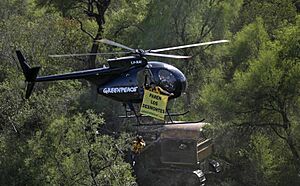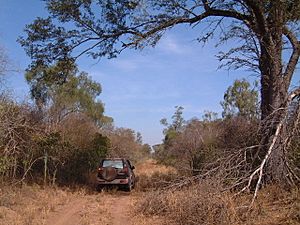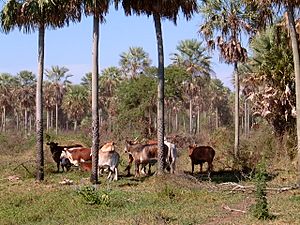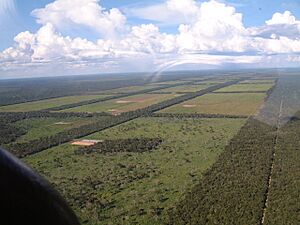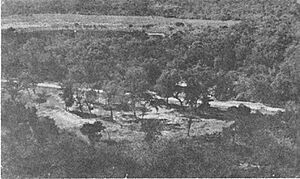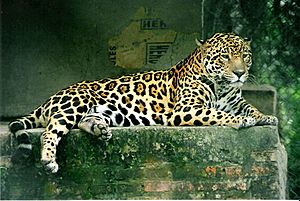Gran Chaco facts for kids
Quick facts for kids Gran ChacoDry Chaco |
|
|---|---|
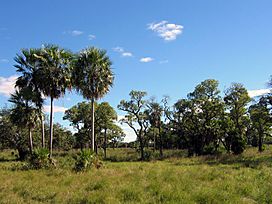
Landscape in the Gran Chaco,
Chaco Boreal, Paraguay |
|
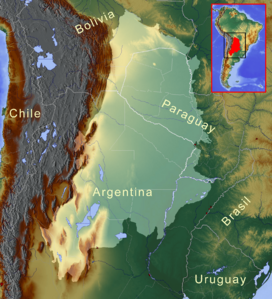
Dry Chaco as delimited by the World Wildlife Fund
|
|
| Ecology | |
| Realm | Neotropical |
| Biome | tropical and subtropical dry broadleaf forests |
| Borders |
List
|
| Geography | |
| Area | 786,791 km2 (303,782 sq mi) |
| Countries | Paraguay, Bolivia, Argentina and Brazil |
| Conservation | |
| Protected | 176,715 km² (22%) |
The Gran Chaco or Dry Chaco is a large, flat natural area in South America. It's a hot, mostly dry lowland region. This area is shared by eastern Bolivia, western Paraguay, northern Argentina, and parts of Brazil. It's sometimes called the Chaco Plain.
Contents
What's in a Name?
The name Chaco comes from the word chaqu in Quechua. This is an old language spoken by native people in the Andes mountains. Chaqu means "hunting land." This name probably came from the many different animals that live in the region.
Geography of the Gran Chaco
The Gran Chaco is a huge area, about 647,500 square kilometers (250,000 sq mi). It lies west of the Paraguay River and east of the Andes mountains. Most of it is a flat plain made of river sediments.
Historically, the Chaco was split into three main parts:
- The Chaco Austral (Southern Chaco) is south of the Bermejo River in Argentina.
- The Chaco Central (Central Chaco) is between the Bermejo and Pilcomayo Rivers, also in Argentina.
- The Chaco Boreal (Northern Chaco) is north of the Pilcomayo River. It stretches into Paraguay and parts of Bolivia.
Today, people often talk about the Argentinian Chaco, Paraguayan Chaco, and Bolivian Chaco. In Paraguay, the middle part of the Chaco Boreal is sometimes called Central Chaco. This is where Mennonite communities have settled.
The Chaco Boreal has two main zones:
- The Alto Chaco (Upper Chaco) is closer to the mountains in the west. It's very dry and has sparse plants. It's also known as Chaco Seco (Dry Chaco).
- The Bajo Chaco (Lower Chaco) is to the east. It gets more rain and has fertile soil. This area has a thorn tree forest that dries out in some seasons. Further east, it can be swampy. This part is also called Chaco Húmedo (Humid Chaco). It has open savannas with palm trees, quebracho trees, and tall grasses.
Areas near the Paraguay, Bermejo, and Pilcomayo Rivers are better for development. The Chaco is a good source of timber (wood) and tannin. Tannin comes from the native quebracho tree. The wood of the palo santo tree is used to make a fragrance for soap. Paraguay also grows mate in the lower Chaco.
Much of the central and northern Chaco has rich, sandy soil. This soil has high levels of phosphorus and is good for farming. However, farming here can be tough. The climate is semi-dry to semi-humid, with a six-month dry season. Fresh groundwater is only found in about one-third of the region. The rest has no groundwater or very salty water. Also, the soil can easily wash away once the forest is cleared. Dust storms can cause a lot of topsoil loss in the Paraguayan Chaco.
History of the Chaco
For a long time, the Chaco was home to nomadic groups like the Guaycuru peoples. They bravely fought against Spanish control from the 1500s to the early 1900s. Before the countries in the Chaco became independent, the Spanish called the whole area Chiquitos.
The Gran Chaco was a disputed territory after 1810. It was supposed to be part of Argentina, Bolivia, and Paraguay. However, Paraguay had claimed a larger part of the land west of the Paraguay River since its independence. Argentina claimed land north of the Bermejo River until the War of the Triple Alliance in 1870. After that war, Paraguay's border with Argentina was set.
Over the next few decades, Bolivia started to settle in the Gran Chaco. Paraguay had mostly ignored the area. Bolivia wanted to reach the Paraguay River to ship oil to the sea. This was important because Bolivia had lost its Pacific coast in the War of the Pacific and became landlocked. Paraguay, however, claimed ownership of the land. This led to the Gran Chaco War (1932–1935) between Paraguay and Bolivia. They fought over oil that was thought to be in the Chaco Boreal.
In the end, Argentina's Foreign Minister, Carlos Saavedra Lamas, helped them agree to a ceasefire. A treaty was signed in 1938. Paraguay received three-quarters of the Chaco Boreal. Bolivia got a path to the Paraguay River. They could use Puerto Casado and build their own port. No oil was found in the region until 2012. That's when Paraguay's President Federico Franco announced oil had been found near the Pirity river.
Mennonite people moved to the Paraguayan Chaco from Canada in the 1920s. More came from the USSR in the 1930s and after World War II. These immigrants built some of the biggest and most successful towns in the deep Gran Chaco.
Today, over 9 million people live in the Gran Chaco. They are spread out across Argentina, Bolivia, and Brazil. About 100,000 people live in Paraguay. The area is still not fully developed. In the 1960s, Paraguay built the Trans-Chaco Highway. Argentina built National Routes 16 and 81. These roads were meant to help people access and develop the area. All three highways are about 700 km (430 mi) long from east to west and are now paved. Brazil also has a network of nine paved highways in Mato Grosso do Sul state.
Plant Life (Flora)
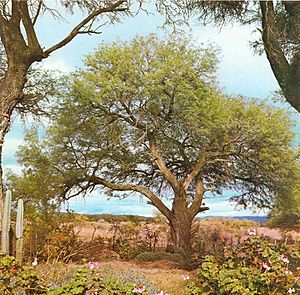
The Gran Chaco can have some of the hottest temperatures in South America. It has a lot of different kinds of plants and animals. There are about 3,400 plant species, 500 types of birds, 150 kinds of mammals, and 220 reptile and amphibian species.
The plants in the Gran Chaco are very diverse because the region is so large. The main type of plant life is dry forests where trees lose their leaves. These forests have many layers, including tall trees, smaller trees, shrubs, and plants on the ground. Other ecosystems include forests along rivers, wetlands, savannas, and areas with many cacti.
In the eastern part of the Humid Chaco, at higher places, the forests are like the wet forests of southern Brazil. These woodlands have tall trees like Handroanthus impetiginosus. They also have many climbing plants (lianas) and plants that grow on other plants (epiphytes). In lower areas, there are forests that flood sometimes. These are dominated by Schinopsis trees, which are often used for their tannin and strong wood. The plants under the trees include bromeliads and cacti.
To the west, in the Semiarid/Arid Chaco, there are medium-sized forests. These have white quebracho (Aspidosperma quebracho-blanco) and red quebracho (Schinopsis lorentzii) trees. There are also many types of cactus trees. In sandy areas, the thick forests turn into savannas. The giant Stetsonia coryne cactus is very noticeable in these sandy savannas.
Animal Life (Fauna)
The Gran Chaco has a wide variety of animals. It's home to about 3,400 plant species, 500 bird species, 150 mammal species, and 220 reptile and amphibian species. Animals usually found in tropical and subtropical forests live in the eastern Humid Chaco. These include jaguars, howler monkeys, peccaries, deer, and tapirs. Animals like anteaters and armadillos are also common here.
The Argentinian Chaco has at least 10 types of armadillos. This makes it a place with the most armadillo diversity. Some armadillos found here are the nine-banded armadillo and the southern three-banded armadillo. The pink fairy armadillo is very special because it's found nowhere else in the world! The giant armadillo lives in the drier Arid Chaco in the west.
Other unique animals in the region include the San Luis tuco-tuco. This small rodent is only found in the Argentinian Chaco. All 60 species of Ctenomys rodents are only found in South America. The Chacoan peccary (called tauga by locals) is the largest of the three peccary species in the area. Scientists thought this animal was extinct until it was seen again in 1975.
Because of the Chaco's climate, reptiles and amphibians often live in moist, sheltered spots. These can be rotting logs, piles of debris, old houses, wells, or seasonal farm ponds. Many bird species live or breed in the Gran Chaco. Some notable ones are the black-legged seriema, blue-crowned parakeet, and guira cuckoo. Out of 409 bird species, 252 are only found in South America.
Conservation Challenges
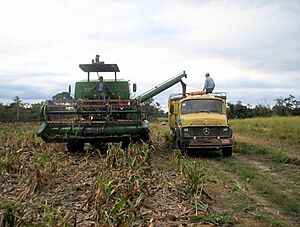
The Chaco is one of the last places in South America where farming is expanding. It's very sparsely populated and doesn't have many good roads or basic services. Because of this, it has been too remote for growing crops for a long time. The Mennonite communities in the central Chaco are a special case.
Two things might change the Chaco a lot soon:
- Land is not very expensive there.
- The region is good for growing fuel crops.
For example, Jatropha has been shown to grow well there. Sweet sorghum could also work as a plant for making ethanol (a type of fuel). Sorghum is already a traditional crop grown there for food and animal feed. Researchers are also studying if switchgrass and the Karanda’y palm tree can be used for fuel.
While new farming methods can bring better roads and jobs, a lot of natural habitat and forests are being lost. This could increase poverty. Paraguay lost over 90% of its Atlantic rainforest between 1975 and 2005. Now, it's losing its dry forests in the Chaco at a rate of 220,000 hectares (540,000 acres) per year (as of 2008). In 2009, a law that would have stopped all deforestation in the Paraguayan Chaco did not pass in parliament.
In the Argentinian Chaco, about 100,000 hectares (250,000 acres) of forest were cut down each year between 2001 and 2007. A local group, Fundación Avina, says that about 1,130 hectares (2,800 acres) are cleared every day. Large soy farms are replacing not only forests but also other types of farming. Native communities are losing their land to big farming businesses. Since 2007, a law is supposed to control logging in the Gran Chaco, but illegal logging still happens.
Some big farming companies from the U.S., like Cargill Inc., Bunge Ltd., and Archer Daniels Midland Co., are investing a lot in the Paraguayan Gran Chaco.
Protected Natural Areas
In 2017, it was found that 176,715 square kilometers (68,230 sq mi) of the Gran Chaco, which is 22% of the ecoregion, are protected areas.
In September 1995, the Kaa-Iya del Gran Chaco National Park and Integrated Management Natural Area was created in Bolivia. This park is special because it is managed and was created only by the indigenous peoples who live there. These include the Izoceño Guaraní, the Ayoreode, and the Chiquitano.
Other protected areas include Defensores del Chaco National Park and Tinfunqué National Park in Paraguay. In Argentina, there are Copo National Park and El Impenetrable National Park.
Regions in the Gran Chaco
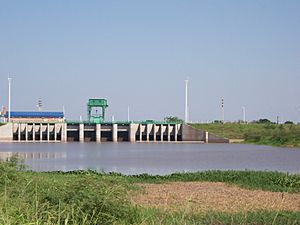
The Gran Chaco covers parts of several provinces, departments, and states in Argentina, Bolivia, Paraguay, and Brazil.
Native Peoples
- Abipón, Argentina, a group from the past
- Angaite (Angate), northwestern Paraguay
- Ayoreo (Morotoco, Moro, Zamuco), Bolivia and Paraguay
- Chamacoco (Zamuko), Paraguay
- Chané, Argentina and Bolivia
- Chiquitano (Chiquito, Tarapecosi), eastern Bolivia
- Chorote (Choroti, Iyojwa'ja Chorote, Manjuy), Argentina, Bolivia, and Paraguay
- Guana (Kaskihá), Paraguay
- Guaraní, Argentina, Bolivia, Brazil, and Paraguay
- Guaycuru peoples, Argentina, Bolivia, Brazil, and Paraguay
- Mbayá (Caduveo), from the past
- Kadiweu, Brazil
- Mocoví (Mocobí), Argentina
- Payaguá
- Pilagá (Pilage Toba)
- Toba (Qom, Frentones), Argentina, Bolivia, and Paraguay
- Mbayá (Caduveo), from the past
- Kaiwá, Argentina and Brazil
- Lengua people (Enxet), Paraguay
- North Lengua (Eenthlit, Enlhet, Maskoy), Paraguay
- South Lengua, Paraguay
- Lulé (Pelé, Tonocoté), Argentina
- Maká (Towolhi), Paraguay
- Nivaclé (Ashlushlay, Chulupí, Chulupe, Guentusé), Argentina, and Paraguay
- Sanapaná (Quiativis), Paraguay
- Vilela, Argentina
- Wichí (Mataco), Argentina and Bolivia
Many of these groups speak or used to speak languages from the Mataco–Guaicuru languages family.
See also
 In Spanish: Gran Chaco para niños
In Spanish: Gran Chaco para niños
- Campo del Cielo
- Kaa-Iya del Gran Chaco National Park and Integrated Management Natural Area
- Tributaries of the Río de la Plata


